Artists' Books
Artists' Books

Three Moral Tales
Joëlle de La Casinière, Ana Jotta and 1 more
The moral tale is a literary genre that was especially popular in Europe throughout the 18th century. As ways of being and doing were strongly tied to conventions assigned to social roles and genres, the rise of rationality and freethought, characteristic of this era, began re-organizing the so-called “natural order” of established patterns. Through fables and satires, moral tales expressed sharp critical views on the social relationships and hierarchies of the time, often using radical irony and cruelty, as in the tales of Jonathan Swift or of the Marquis de Sade, to decipher the untold rules at play in this early age of capitalism.
The works of the three artists invited to these Three Moral Tales are not that of moralists, but somehow assume a kind of moral dimension, as they present themselves as critical allegories. Joëlle de La Casinière, Ana Jotta and Anne-Mie Van Kerckhoven make use of fables and sometimes caricatures to observe and criticize the cruelty of human relationships. The “moral tales” narrated by these three artists scrutinize representations of evil, and mock hierarchies, traditions and social order. By doing so, they also follow up on a certain spirit of the iconoclastic avant-gardes of the early 20th century.
French artist Joëlle de la Casinière, Portuguese Ana Jotta and Flemish Anne Mie Van Kerckhoven have in common to pay no fealty to trends of contemporary art. Moreover, they fought unwaveringly throughout their respective careers the need to see their work being given an “official line”. Instead, they stood aside, went underground or remained indifferent to the twists and turns of the art market and institutions. They sometimes created surrogate characters, hid, or playfully modified their names to react to the branding of identity in the artworld, and to the imposed marginalization that they had to cope with as women artists, as did artists living in peripheral geographies. In a way, paradoxically, being marginalized encouraged a calculated versatility of media and styles, and the invention of an idiosyncratic vocabulary, while total freedom remained their one and only rule.

Serving Compressed Energy With Vacuum
Published in conjunction with an exhibition at Kunstverein München, this catalogue is presented as an integral part of the show, augmenting it through the presentation of subjects, aspects, and themes which are better suited to the printed medium or demand another kind of involvement. Anne-Mie Van Kerckhoven’s works involve painting, drawing, digital media, and video, and reflect her fascination from a female point of view with the representation of women in mass media, the connections between sex and technology, different knowledge systems, and the unconscious. Besides numerous works, projects, and images, the book includes insightful explanations by the artist.

Klosterruinenzines
Anna M. Szaflarski, Simone Fattal and 2 more
Four zines, documenting and continuing a series of four exhibitions that took place last summer, also known as the summer of 2021 at Klosterruine Berlin. Digging up what’s always already left behind, this series reframes the exhibition as an excavation site and engages archeology as a speculative and aesthetic procedure. A map, a notebook, a calendar and a dream diary, these four zines allow you to become your own archeologist.

Shell Reader
Literally crumbling under our own weight, several metric tonnes of shells speak up from the ground, causing a sensation remote from that of walking on a gallery floor. Yet, crushed calcite from marine molluscs is an essential ingredient in concrete, a major constituent of our built environment. In Muscle Memory, a sculpture by Nina Canell, the biomineral forms that feed the construction industry gradually break down over the course of the exhibition. Material stress gives way to a sounding, durational sculpture, inviting us to consider the ineffable number of broken bodies that holds us up. Shell Reader calls on the material vitality of calcium carbonate, detailing broken pieces of shell from Muscle Memory. By foregrounding these fragments, each page echoes a crack, snap, split, or splinter.
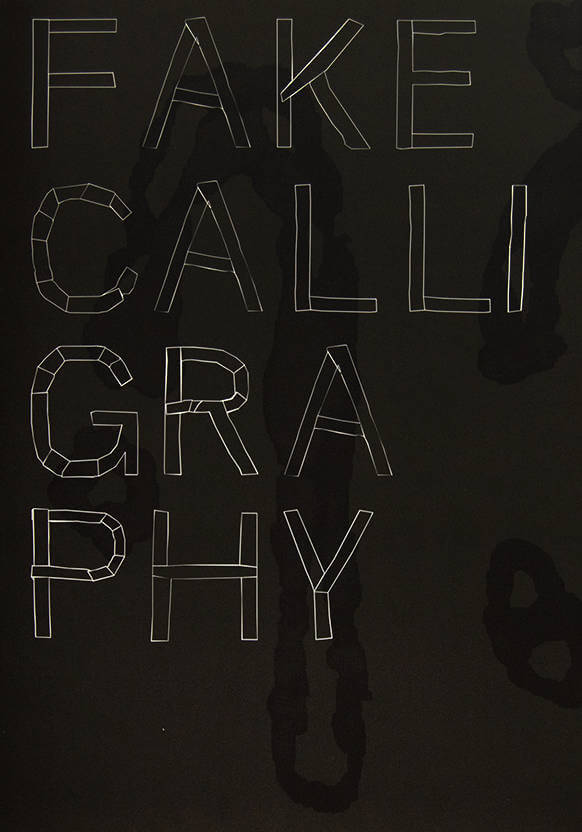
Fake Calligraphy
Ada Van Hoorebeke, Maartje Fliervoet and 1 more
Fake Calligraphy is a mobile sculpture consisting of a simple set of metal frames, batik, and tools that are used in repeated collective performances. The sculpture serves as a workshop where patterns based on pseudo-writing are collectively produced. The publication documents a joint making process along with some of the techniques that are applied here, such as dyeing with natural dyes and wax batik.
Fake Calligraphy is an ongoing work made by many participants, developed and facilitated by Ada Van Hoorebeke, Maartje Fliervoet, and the artistic platform manoeuvre. Amongst other places Fake Calligraphy was performed and shown at WIELS Contemporary Art Centre, Brussels, Kunsthal Gent, (Ghent) and at homes and studio’s of contributors in Ghent, Serekunda, Brussels, The Netherlands, and Berlin.
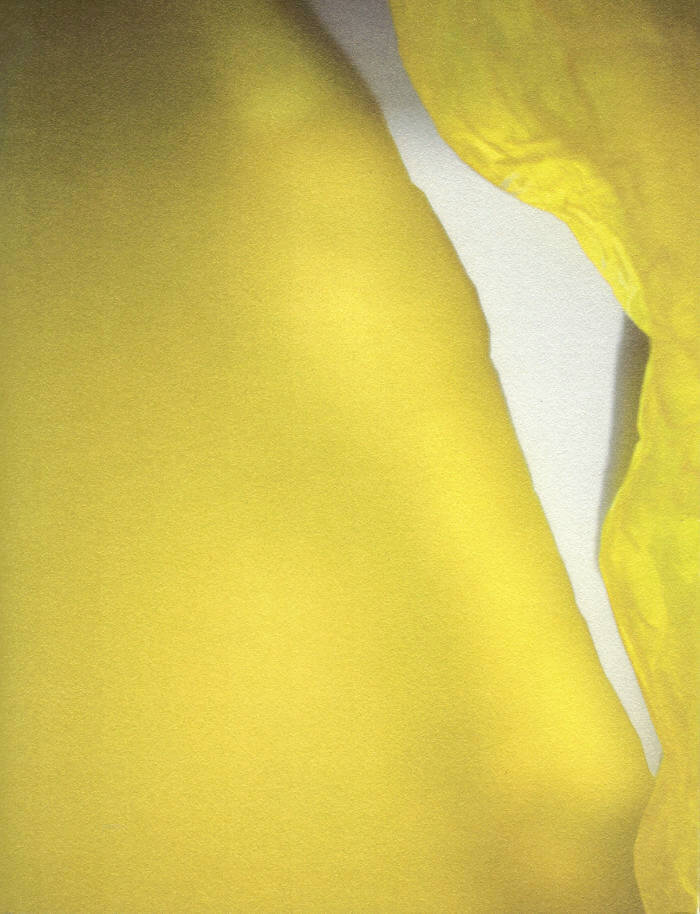
El Plástico, the Sun that lives inside the Rock
Viktorija Rybakova, Goda Budvytytė
This publication El Plástico, the Sun that lives inside the Rock is an observation on evolution of material plasticity, it is a story about plastic whose native land is Mesoamerica. It explores the past, present and future of plastic through encounters with various people — a weaver from Oaxaca, a taxi driver, a sociologist working on trash collection in Mexico City and the owner of a small family-run plastic factory. The book contains a polymorphous project resulting from several years of research by artist Viktorija Rybakova and designer Goda Budvytytė, it also includes a conversation between philosophers Kristupas Sabolius and Catherine Malabou, and essays by Post Brothers and Chris Fitzpatrick.
Editor: Goda Budvytytė and Viktorija Rybakova
Texts: Goda Budvytytė, Chris Fitzpatrick, Catherine Malabou, Post Brothers, Viktorija Rybakova, Kristupas Sabolius

Taming a Wild Tongue
Laura Cemin, Bianca Hisse and 1 more
Referring to Gloria Anzaldúa's notion of 'wild tongue' (Borderlands/ La Frontera, 1987), the publication departs from the questions: How to tame a wild tongue? How to carry language? The verbs 'taming' and 'carrying' imply certain dynamics of permission and restriction of movement, and suggest the entanglement between language and the body. The project delves into the notion of 'tonuge' as an archive: the 'tongue' as a muscle shaped by the physical practice of moving/ talking, having memory; the 'tongue' as a 'cultured' part of the body. It addresses accent as part of our linguistic identity, but also something that defines access or restriction. (From Monika Charkowska's preface to the publication)
Artists: Bianca Hisse, Laura Cemin
Curated by: Monika Charkowska
Texts by: Monika Charkowska, Claire Goodall, Kübra Gümüsay, Bianca Hisse, Laura Cemin
Edited by: Monika Charkowska
Translations: Epp Aareleid (ENG to EST), Ksenia Krimer (ENG to RUS), Keiu Krikmann (ENG to EST), Anita Kodanik (ENG to RUS)
English Proof-Reading: Epp Aareleid
Graphic Design: Kersti Heile
Edition of 200.

Emmy Hennings / Sitara Abuzar Ghaznawi
Emmy Hennings, Sitara Abuzar Ghaznawi
As a cofounder of Cabaret Voltaire in 1916, Emmy Hennings, with her partner, the Dadaist Hugo Ball, is recognized as having established and environment for collective experimentation. This book gathers an extensive collection of Hennings's writings, ephemera, and art, to give shape to a practice and an individual so ofter flattened for the sake of art historical narrative.
In the exhibitions held at Cabaret Voltaire and at the Swiss Institute in 2020, Sitara Abuzar Ghaznawi made evocative displays that created space for a deeper engagement with Hennings's life and art. For this publication, she has made new collages, combining found materials and working tools suck as adhesive strips, supplemented by graphic gestures and subjective indexes such as cigarette butts. By bringing the Hennings archive into dialogue with her own work, Ghaznawi considers the manner in which an individual's multiple identities guide the accumulation of personal experience, be they her own or those of a woman she never met. Commissioned on the occasion of her exhibitions, and published together here for the first time, are texts by Ghaznawi's friends and collaborators Michael Zimmerman, Samuel Lala, Nils Amadeus Lange, Sophia Rohwetter, Der Serpas, Olamiju Fajemisin, Samiran Istifan, Timur Akhmetov and Furqat Palvan-Zade.
Published following the exhibitions Emmy Hennings / Sitara Abuzar Ghaznawi at Cabaret Voltaire, Zurich, and the Swiss Institute, New York, in 2020-2021.
Emmy Hennings (1885–1948) was a writer, actress, cabaret artist and co-founder of the artists' bar with Hugo Ball, and probably the most present figure at Cabaret Voltaire. The fact that she received little attention as a writer and artist may be due to various reasons. Perhaps it was the distinct language, or the general uneasiness at dealing with her Catholicism; whatever it was, her trace is missing in the male-dominated Dada historicisation. Only recently has Hennings received recognition, and indeed beyond the role of cabaret star. Whoever reads her novels, poems, and reviews will encounter a woman for whom writing was a survival strategy. She astutely analyses her existence and stages herself as a multiple.
Sitara Abuzar Ghaznawi (born 1995 in Ghazni, Afghanistan) lives and works in Zurich and Obwalden. Her assemblages transgress forms and space, revealing a questioning of institutional structures and accepted ideas of craft and taste. In her sculptural transformations her processes insist on maintaining the visibility of the lowly beginnings of her materials, forming strong, shameless and rigorous poetries.
Edited by Simon Castets and Salome Hohl.
Texts by Salome Hohl, Laura McLean-Ferris, Michael Zimmerman, Samuel Lala, Nils Amadeus Lange, Sophia Rohwetter, Der Serpas, Olamiju Fajemisin, Samiran Istifan, Timur Akhmetov, Furqat Palvan-Zade.
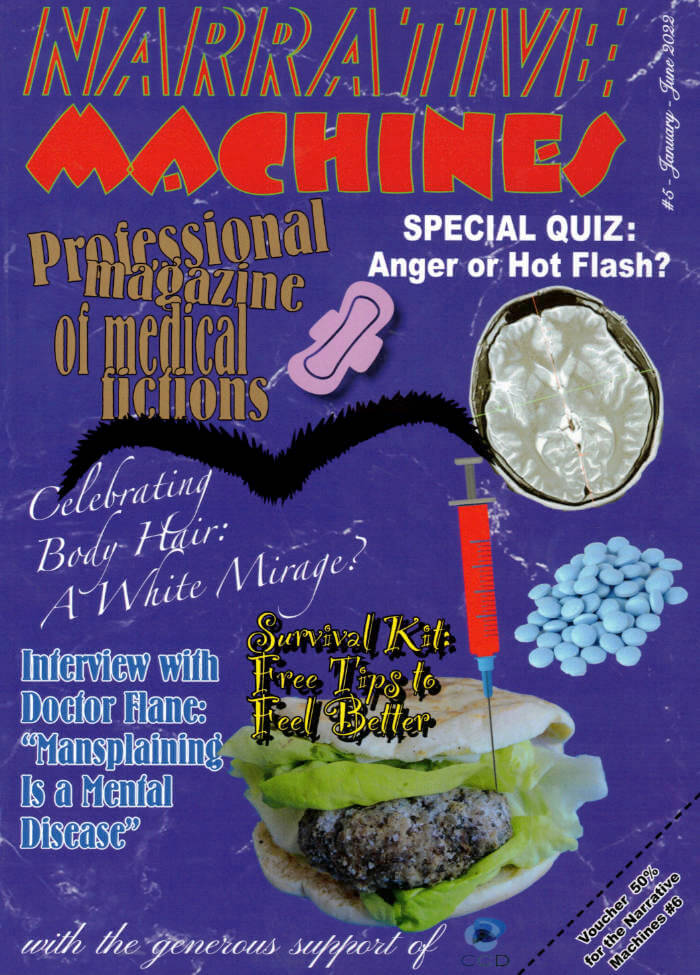
Narrative Machines – Professional magazine of medical fictions
An artist's book disguised as a medical publication written by six fictional women characters from Morocco in free wheeling, Narrative Machines clothes truth with falsehood. With wry irony and Google English it comments on paranoia, fake news, patriarchy, power and media ganging together in the Maghreb (and everywhere else). But it also shows a chosen community of women who confide, support each other and laugh a good load.
Are there weird questions that have been haunting you all your life? Do you wonder why you pass out each mother in law comes to your place? Do you smell fish when you cook meat? Do you know of miraculous medical machines that have been forgotten by official history? What's your take on alternative medicine? Have you ever heard about the Markar, the cardiological device invented by King Hassan II of Morocco? Do you love watching Noujoum Al 3ouloum (Stars of Sciences)? Is your herbalist your best friend? Do you ever wonder if you should wax your arms? In your daily life, do you struggle sometimes with your feminist ethic? Do you put snail cream on your face? Write to us! Join our community! Be part of the Narrative Machines family!
Ghita Skali (born 1992 in Casablanca) is an artist based in Amsterdam. She studied in France, first at Villa Arson, Nice then at the post-graduate program of the Fine Arts School in Lyon. She was a De Ateliers (Amsterdam) resident between 2018 and 2020. She notably exhibited recently at Kunsthal extra City (Antwerp), Palais de Tokyo (Paris) and at the Stedelijk Museum (Amsterdam).
Texts by Kaoutar Chaqchaq, Ayla Mrabet, Ghita Skali
Graphic design: Roxane Maillet

Bodies in Scattered Light
New series of paintings by the Swiss artist, that examine the role of humankind in nature and within its social fabric on a philosophical-anthropological level.
"I asked Andriu Deplazes if he had always wished to be a painter. No, he said. For a time, he had trained to be a classical musician, but turned away from music because there was something repellent about the need to demonstrate virtuosity. To be a virtuoso, as the moral world depicted in these paintings clearly shows, is not the same as having virtue. And yet, at the same time, there are still traces of virtuosity in Deplazes' practice: in the idealised landscapes that he renders, and in the easy depiction of animal life. It is only humans that he will not denigrate with such perfection. Their overpainted faces do not allow them to be captured as things, but rather present them as subjects. They elude categorisation because they are responding, in real time, to what they see in us." Adam Jasper
Born 1993 in Zurich, Andriu Deplazes lives and works in Zurich, Brussels and Marseille. His paintings create a kind of parallel cosmos that questions the habitual ways of seeing and expectations of the beholder. Wide landscapes in colourfully powerful large format are the setting for curious characters who sometimes melt into the vegetation around them or appear strangely remote from it. His work has been exhibited throughout Europe since 2015.
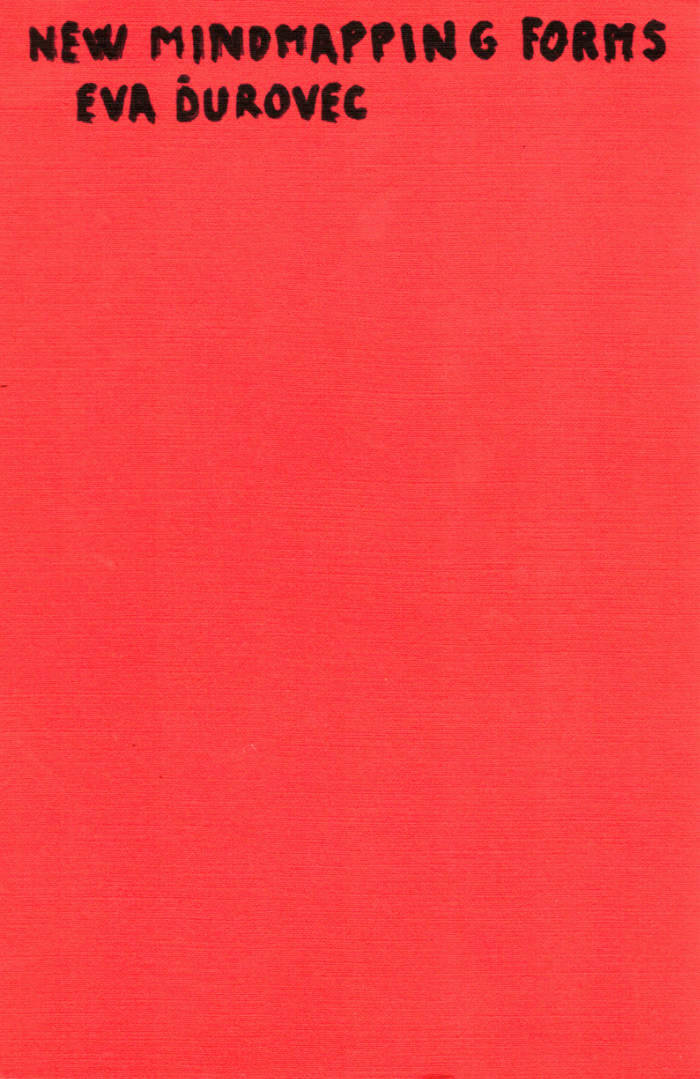
New Mind Mapping Forms
There is a story about a meatball which comes out of nowhere, hitting some people's heads and changing their lives forever. There is a mouse that gets caught while trying to find a cheesy snack. There has been a 100% increase in the cost of rent in Berlin in the past 10 years and no increase in my wages. A bag full of basmati rice. A teacher stuck at work waiting for students stuck at work. There is the price one pays to purchase organic underwear so that their intimate parts are not stifled from nine hours in the office chair. There are 10 missed calls from my mother. There are places to which one cannot return and cities where it is impossible to live. There are fertility treatments that send fish oil straight into the veins two days before and two days after ovulation. The feeling of a needle in the middle of the uterus, which could be due to pregnancy, or due to fear. There is a Master's thesis which is no Master's thesis. There is a book that was not intended to be published, that was not intended to be read.
Eva Ďurovec works as a software tester 40 hours per week and studies art at the same time. There are not enough hours in the day to complete everything, to comply with everything. And then there is also her desire to have children. The question: how can all of this be reconciled within the profession of artist? Ďurovec investigates the possibilities that arise from different class formats, and asks what we produce and reproduce—with our bodies, through our routines, trapped between the recurring desires and cruelties of daily life.
Eva Ďurovec (*1981 in Snina, former Czechoslovakia) studied Spatial Strategies at Kunsthochschule Berlin-Weiensee. Her work deals with living-space and life-fulfillment in the context of social, economic, and environmental crises, and with issues of corporate power and kleptocracy.
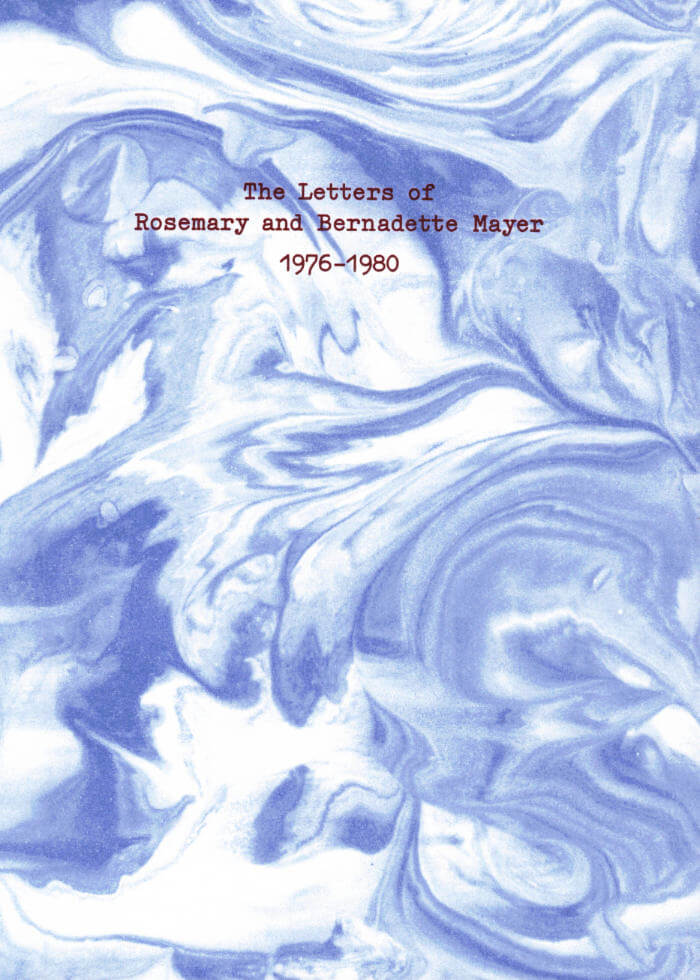
The Letters of Rosemary & Bernadette Mayer, 1976-1980
Bernadette Mayer, Rosemary Mayer
This collection of the correspondence between artist Rosemary Mayer (1943-2014) and poet Bernadette Mayer (born 1945) occurs between the years of 1976 and 1980, a period of rich creativity in New York's artistic avant-garde, and one which includes the development of major bodies of work by the two women.
Rosemary Mayer was creating sculptures, watercolors, books and temporary monuments from weather balloons and snow, while Bernadette Mayer was working on some of her best-known publications, including the book-length poem Midwinter Day and the poetry collection The Golden Book of Words.
Spanning the worlds of Conceptual art, Postminimalism, feminism, the New York School, Language poetry and more, these letters elucidate the bonds of sisterhood through intimate exchanges about art, relationships and everyday life.

From The Prop To The Inside
FROM THE PROP TO THE INSIDE gathers texts on the concept of the prop—as object, requisite and support—on stage and in the exhibition space. The starting points of this book are objects and installations of the artist Michaela Schweighofer, which deal with the stage as a platform and the sculpture as a prop.
The authors are friends: artists, critics and curators whom she has invited to write a text at the interface of their and her practice. The contributions within take on multiple forms; letters, essays and interviews—they are intended to create a theoretical-subjective anthology that makes visible the phenomena of the private as symptoms of the structural, as well as to provide a direct insight into contemporary artistic creation.
Text: Juliane Bischoff, Veronika Eberhart, Cornelia Lein, Cathrin Mayer, Gianna Virgina Prein, Agnieszka Roguski, Juliane Saupe, Michaela Schweighofer & Chloe Stead

Noa & Snow – Poem #9
This book/catalogue is published on the occasion of the final event of Noa & Snow, a gentle experiment between the everyday and the event, at the Volkskundemuseum, Vienna.
Publication Concept Alix Eynaudi, Goda Budvytytė
Design Goda Budvytytė
Printing Robstolk, Amsterdam
Edition 600 copies
Proofreading Bella Marrin
ENVELOPE Pattern design based on the Lila Dress and its signature cording by An Breugelmans
LE VESTIAIRE
Costumes & objects An Breugelmans Tapestries & trompe-l’oeil Cécile Tonizzo Weaves Lydia McGlinchey Photos taken inside of Jason Dodge’ show Cut a Door in the Wolf at Macro Museum by Carlotta Pierleoni Photos in Vienna Samuel Feldhandler
THEM, PROTEXTIONS
Han-Gyeol Lie, Mette Edvartsen, Lydia McGlinchey, Clara Amaral, Ujjwal Kanishka Utkarsh, Jennifer Lacey, Cécile Tonizzo, Sabina Holzer, Alice Chauchat, Jason Dodge, Joachim Hamou, Quim Pujol, Litó Walkey, Serena Lee, Mihret Kebede
PUBLIC MEDITATIONS
Anne Faucheret, Elizabeth Ward, Kirsty Bell, Tony Just, Sabina Holzer, Samuel Feldhandler, Frida Robles
TEXTURAGES Paula Caspão VIGNETTES Alix Eynaudi
Poster picture of Claire Lefèvre’s Grimoire/Giant Notebook/Bison Book Rasa Juškevičiūtė
INSTITUTE OF REST(S)
Alix Eynaudi, Paula Caspão, Quim Pujol
Back side A thread for Alix Eynaudi, woven as a table placement by Genė Janušauskaitė in 1936, out of the flax she had sawn and harvested herself. Photographed by Kristien Daem in 2022, after Aldona Malašauskienė revealed the placement to her son Raimundas.

Earwitness Inventory
The ninety-six objects in this inventory are sourced from earwitness interviews Lawrence Abu Hamdan conducted as well as from trial transcripts across the globe. After SFX explores the ways we remember sound and the ways in which cinematic sound effects have created a collective acoustic unconscious. What is revealed is our difficulty in describing these memories when precision is vital. The objects listed here stand in for a missing sonic vocabulary, a language we do not yet speak. [publisher's note]

Tense (Silver Edition)
Tense is a never-realised publication, written and composed by Lucy Lippard and Jerry Kearns in 1984, that only now has been released in a very limited run on our imprint. The book accompanied the exhibition Top Stories, which took a closer look at the 29 issues of the prose periodical with the same title, founded in the late 1970s by Anne Turyn.
Top Stories was dedicated to fiction by emerging women artists and writers from that time. Tense was originally intended to become part of the series as well, but never made it to print. It was only recently – during the making of the exhibition at Amsterdam’s Kunstverein – that the original mock-up was retrieved from the editor’s archives and finally sent off to the printer.
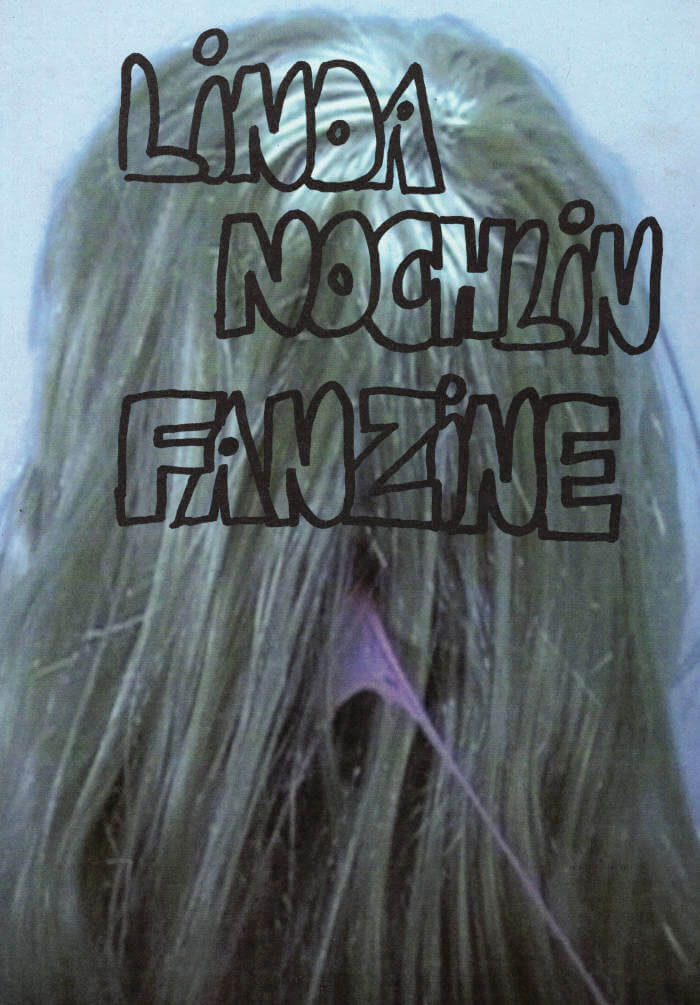
Linda Nochlin Fanzine
More than 130 artists and authors from different generations participated in 2021 in an open call to mark the 50th anniversary of Linda Nochlin's essay, Why Have There Been No Great Women Artists? This resulted in four digital fanzines that we now turned into a fierce publication in the tradition of the first feminist print work. Chloé D'hauwe took care of the no fuzz design.
Editors: Els Roelandt and Jessica Gysel
Texts: Olave Nduwanje and Delphine Bedel (ao)
Translations: Irene de Craen en Euphemia Ophelders
Design: Chloé D’hauwe
Cover: Christine Clinckx, Penelope, video still 2004
Print: Antilope de Bie Printing, Duffel
Riso: Risiko Press, Borgerhout
Year: 2022
Amount of pages: 228
Dimensions: 28 x 21 cm
Edition: 600 copies
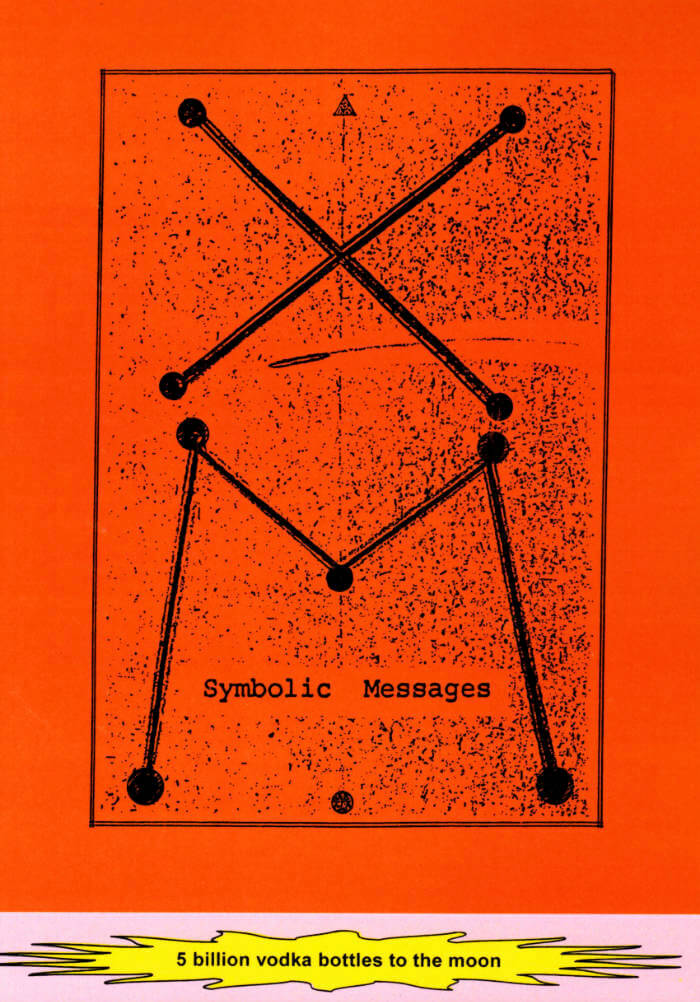
Symbolic Messages - An Introduction to a Study Of "Alien” writing.
Mario Pazzaglini, Moritz Appich and 2 more
This book is a reprint from a scan of what appears to be the last remaining copy of Symbolic Messages in public libraries worldwide, at the university library of Manitoba College, Canada. Clinical psychologist Mario Pazzaglini first published his extensive collection of case studies in alien writing and received scripts in 1991. This book is a photocopy of the original edition. Editorial manipulations of the material are minimal and where they have been made, it was from lack of information or else for reasons of practicality and cost efficiency: There is no solid evidence of the original binding, printing technique, paper, etc. The original book seems to have been layed out in American letter format and has been scaled down to fit the proportions of European ready-to-order print formats and provide easier readability. Apart from these minor adjustments, the copy is as faithful to the original, as possible.

Sun of an Ignored Putrid Productivity
Bárbara Acevedo Strange, Eva Tatjana Stürmer
Sun of an Ignored Putrid Productivity is a speculative novel about the influence of artificial intelligence and accelerating technological progress on our human interactions. The dialogical script is based on personal reflections and pop-cultural, scientific and philosophical references from the beginnings of cybernetics to more recent voices. Randomly generated, constructed and quoted contents cannot be distinguished from each other. The borderline between fact and fiction becomes blurred. What is left is a flickering effect, disorientation, which reflects our perception of reality under conditions of never-ending information overflow.

Time has fallen asleep in the afternoon sunshine
Ik ben Elias of het gevecht met de nachtegalen, door Maurice Gilliams
For the project Time has fallen asleep in the afternoon sunshine a group of people/ performers memorize a book of their choice. Together they form a library collection consisting of living books. After years of learning by heart and reciting for readers, some of the books have now been written down from memory to create new editions, versions resulting from this process. This book is one of those books, chosen by one person, learned by heart and recited many times, and now written down again from memory. This edition is not a re-edition of the original text. It is a re-writing of the text after the process of reading, memorizing and reciting, with all the alterations that might have occured in the course of this process.

William Wegman: Writing by Artist
The long-awaited compendium of Wegman's hilarious, ingenious writings and language-centric art, from the early 1970s to the present.
While he's famous the world over for his instantly recognizable images of Weimaraner dogs, William Wegman has long been one of Conceptual art's true innovators. Filled with previously unknown and wildly entertaining texts, drawings and early photos, Writing by Artist is the first collection to focus on Wegman's longstanding and deeply funny relationship to language.
This career-spanning edition presents a thematically organized selection of rediscovered writings dating back to the 1970s and 1980s, alongside landmark early photographs and hilarious drawings from throughout his career. All of the works brilliantly incorporate words in one form or another, altering logic and pushing the boundaries of what artist writing can be. Writing by Artist serves as a genuine epiphany for those only familiar with his later work, and a welcome reminder of his madcap inventiveness for the already enlightened. What you do or don't know about William Wegman now conveniently fits into this strangely beguiling book.
William Wegman was born in 1943, in Holyoke, Massachusetts. He received a BFA in painting from the Massachusetts College of Art, Boston, in 1965 and an MFA in painting from the University of Illinois, Champagne-Urbana, in 1967. By the early '70s, Wegman's work was being exhibited in museums and galleries internationally. In addition to solo shows with Sonnabend Gallery in Paris and New York, Situation Gallery in London and Konrad Fisher Gallery in Düsseldorf, his work was included in such seminal exhibitions as When Attitudes Become Form and Documenta V, and was regularly featured in Interfunktionen, Artforum and Avalanche magazines. Wegman has created film and video works for Saturday Night Live and Nickelodeon, and his video segments for Sesame Street have appeared regularly since 1989. In 1995, Wegman's film The Hardly Boys was screened at the Sundance Film Festival. Wegman has appeared on The Tonight Show with Johnny Carson and with Jay Leno, The David Letterman Show and The Colbert Report.

Sforzando - Pastels 2020 - 2022
At midday, March 17th, 2020, Macron’s government decided to place France in suspended animation. Total confinement. The first in a series of strict debilitating lockdowns to combat the spiralling Covid-19 pandemic. This first confinement lasted 55 days. It ended on 11th May 2020. The first part of a dramatic trilogy.
One month in, in April 2020, David West picked up a box of pastels that used to belong to his mother. He had had them for many years but never used them. New to the medium, locked in his Paris studio, he sets himself to the task. Naturally, violence ensues. Folk horror. Animals are disembowelled. Faceless sexualised female bodies perform. Screaming faces educate. Covered figures stand motionless. Shadows. Hooded beings populate. Stabbing, scratching, fading, softening, sforzando. Crescendo. Schadenfreude.
Occasional respite comes when West ventures outside - andante - but the externalised screaming pushes him back in. Hagazussa. Ghosts from West’s past, real and unreal, appear and disappear, figures and shapes, compositional arcs, a slimy snaking emerald hand parts the waves for colour to gush forth a new language verde fosforescente, worm purple, rosa shocking, vermillion, cobalt, ultra-black.
This book reproduces a small selection of some 300 works, in chronological order, in an attempt to document time, evolution, revolt, epiphany and joy. Joy in colour, horror, form, symphony, and finally, West’s visions of a new utopia. Marcato. Decrescendo.
Softcover (21cm x 29.7cm)
100 Pages
50 copies
Signed and numbered by David West
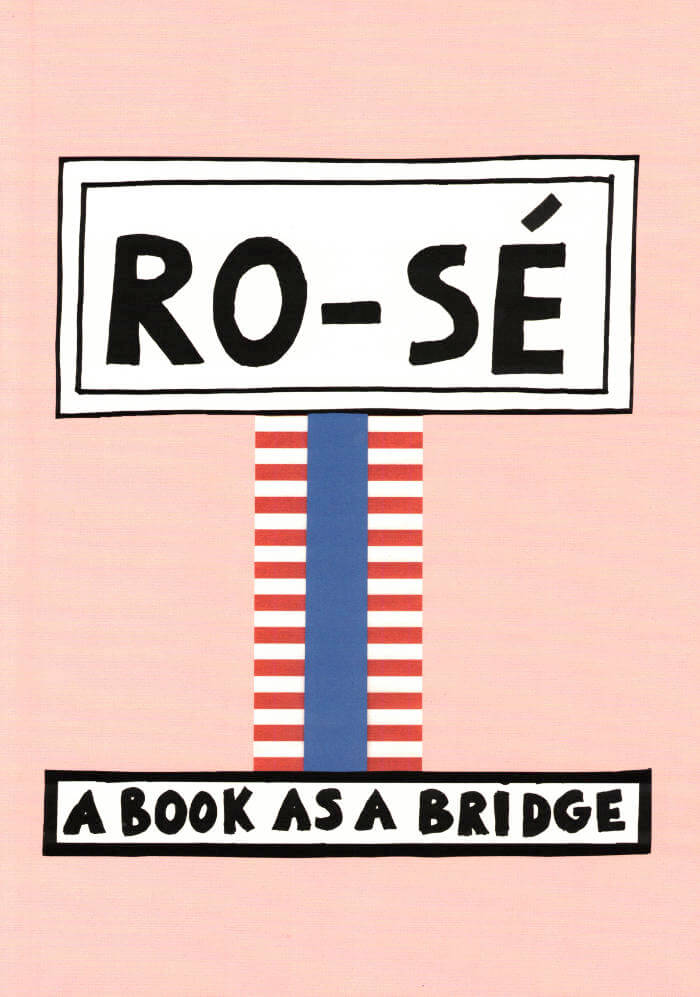
RO-SÉ – A Book as a Bridge
A hybrid monograph/artist book of Nathalie Du Pasquier's work.
Published on the occasion of Nathalie Du Pasquier's solo show at MACRO – Museum of Contemporary Art of Rome, this book navigates the space between an exhibition catalogue and the artist book with juxtapositions of photographs of Nathalie Du Pasquier' works, installation views of the show at MACRO, and extracts from texts by various writers and figures fundamental for her practice. These come together to create an extension of the exhibition itself, in a form that channels the spirit of the show: the pages become exhibition spaces embracing associations and combinations allowing for a deeper understanding and exploration of Du Pasquier's work, and her imagination at large. It is a glimpse into the possibilities offered by her oeuvre, which can be approached, interpreted, and experienced from countless perspectives. It is the very vastness and variety of her work, and her inspirations, that make the exploration of her work—and as a result this publication—non-exhaustive. This publication is part of an ongoing study of her work and documents her exhibition at MACRO, "Campo di Marte," Du Pasquier's biggest show to date which brought together over one-hundred paintings, sculptures, drawings, prints, and cabins, from the early 1980s to present day.
A famous designer and co-founder of the Memphis group in Milan in 1981, Nathalie Du Pasquier (born 1957 in Bordeaux, France, lives in Milan, Italy) accompanied the (post)modern adventure around designer Ettore Sottsass, with the creation of objects, fabrics, carpets, and furniture.
Edited by Luca Lo Pinto.
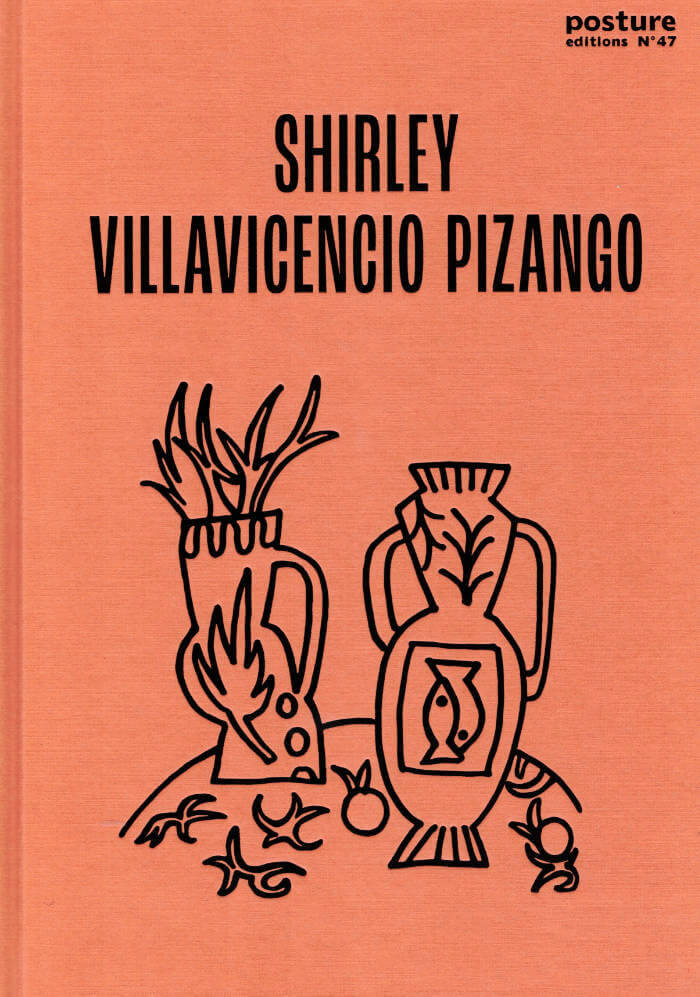
Dark Empathy
Shirley Villavicencio Pizango (b. 1988, Lima) is a Ghent-based artist with Peruvian roots. The cross-fertilization between her childhood in the Amazon jungle and Lima on the one hand, and her life in Belgium on the other, fundamentally characterizes her work.
Her young oeuvre consists of still lifes with terracotta vases, fruits or plants and decorative, colourful backgrounds. She also paints scenes for which mostly friends or family sit as models. Though it may seem that Shirley’s scenes are anchored in reality, the scenes on canvas have never taken place as a whole and her models have been transformed into characters in a constructed setting, where they are quietly allowed to be vulnerable or simply who they are.
Even the clothes and patterns are usually imaginary. Colours sometimes run; some parts appear to be left unfinished or blank.
Posture Editions N° 47, ‘Dark Empathy’, is a multi-layered hardcover presenting a selection of paintings from the last three years, interspersed with powerful drawings on paper and photographs of the artist in her studio. Bart Cassiman collected quotes to accompany the work and added some well-chosen observations by himself. The text ‘Inspired imagination’ by Benedicte Goesaert is the result of a frank conversation between the author and the expressive, generous, self-confident, but at times also melancholy artist.
"White lips refer to my memories of those moments I could not communicate with anyone because I did not yet master the Dutch language. At that time, I made drawings in which the mouth was altogether absent. Later it regained its place. The lips are often serenely pressed together because I want to immortalize the characters. For me, laughter is linked to the ephemerality of a moment. I find it fascinating to have the characters wait quietly without clear indication of what they are waiting for."
— Shirley Villavicencio Pizango in: Benedicte Goesaert, ‘Inspired Imagination’.